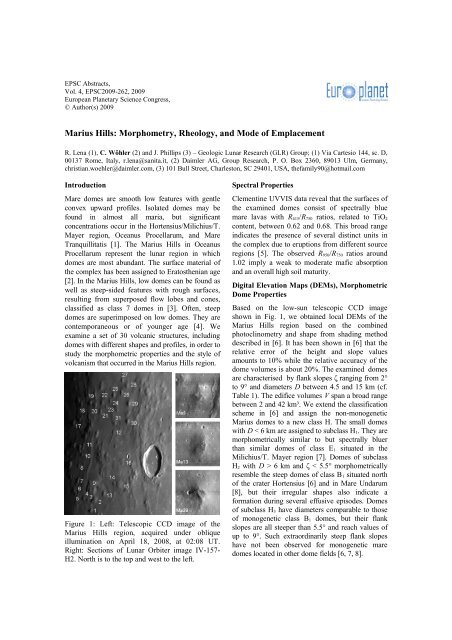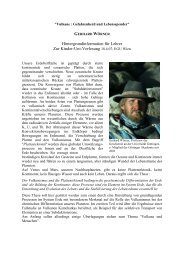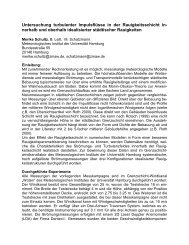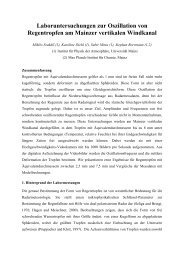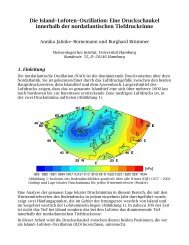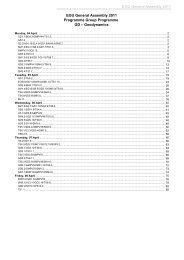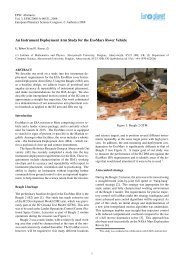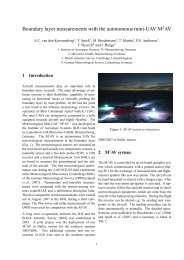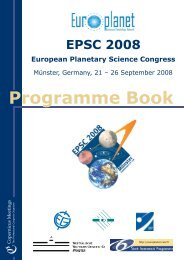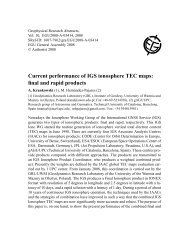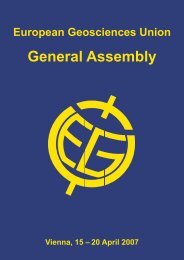Marius Hills: Morphometry, Rheology, and Mode of Emplacement
Marius Hills: Morphometry, Rheology, and Mode of Emplacement
Marius Hills: Morphometry, Rheology, and Mode of Emplacement
You also want an ePaper? Increase the reach of your titles
YUMPU automatically turns print PDFs into web optimized ePapers that Google loves.
EPSC Abstracts,<br />
Vol. 4, EPSC2009-262, 2009<br />
European Planetary Science Congress,<br />
© Author(s) 2009<br />
<strong>Marius</strong> <strong>Hills</strong>: <strong>Morphometry</strong>, <strong>Rheology</strong>, <strong>and</strong> <strong>Mode</strong> <strong>of</strong> <strong>Emplacement</strong><br />
R. Lena (1), C. Wöhler (2) <strong>and</strong> J. Phillips (3) – Geologic Lunar Research (GLR) Group; (1) Via Cartesio 144, sc. D,<br />
00137 Rome, Italy, r.lena@sanita.it, (2) Daimler AG, Group Research, P. O. Box 2360, 89013 Ulm, Germany,<br />
christian.woehler@daimler.com, (3) 101 Bull Street, Charleston, SC 29401, USA, thefamily90@hotmail.com<br />
Introduction<br />
Mare domes are smooth low features with gentle<br />
convex upward pr<strong>of</strong>iles. Isolated domes may be<br />
found in almost all maria, but significant<br />
concentrations occur in the Hortensius/Milichius/T.<br />
Mayer region, Oceanus Procellarum, <strong>and</strong> Mare<br />
Tranquillitatis [1]. The <strong>Marius</strong> <strong>Hills</strong> in Oceanus<br />
Procellarum represent the lunar region in which<br />
domes are most abundant. The surface material <strong>of</strong><br />
the complex has been assigned to Eratosthenian age<br />
[2]. In the <strong>Marius</strong> <strong>Hills</strong>, low domes can be found as<br />
well as steep-sided features with rough surfaces,<br />
resulting from superposed flow lobes <strong>and</strong> cones,<br />
classified as class 7 domes in [3]. Often, steep<br />
domes are superimposed on low domes. They are<br />
contemporaneous or <strong>of</strong> younger age [4]. We<br />
examine a set <strong>of</strong> 30 volcanic structures, including<br />
domes with different shapes <strong>and</strong> pr<strong>of</strong>iles, in order to<br />
study the morphometric properties <strong>and</strong> the style <strong>of</strong><br />
volcanism that occurred in the <strong>Marius</strong> <strong>Hills</strong> region.<br />
Figure 1: Left: Telescopic CCD image <strong>of</strong> the<br />
<strong>Marius</strong> <strong>Hills</strong> region, acquired under oblique<br />
illumination on April 18, 2008, at 02:08 UT.<br />
Right: Sections <strong>of</strong> Lunar Orbiter image IV-157-<br />
H2. North is to the top <strong>and</strong> west to the left.<br />
Spectral Properties<br />
Clementine UVVIS data reveal that the surfaces <strong>of</strong><br />
the examined domes consist <strong>of</strong> spectrally blue<br />
mare lavas with R415/R750 ratios, related to TiO2<br />
content, between 0.62 <strong>and</strong> 0.68. This broad range<br />
indicates the presence <strong>of</strong> several distinct units in<br />
the complex due to eruptions from different source<br />
regions [5]. The observed R950/R750 ratios around<br />
1.02 imply a weak to moderate mafic absorption<br />
<strong>and</strong> an overall high soil maturity.<br />
Digital Elevation Maps (DEMs), Morphometric<br />
Dome Properties<br />
Based on the low-sun telescopic CCD image<br />
shown in Fig. 1, we obtained local DEMs <strong>of</strong> the<br />
<strong>Marius</strong> <strong>Hills</strong> region based on the combined<br />
photoclinometry <strong>and</strong> shape from shading method<br />
described in [6]. It has been shown in [6] that the<br />
relative error <strong>of</strong> the height <strong>and</strong> slope values<br />
amounts to 10% while the relative accuracy <strong>of</strong> the<br />
dome volumes is about 20%. The examined domes<br />
are characterised by flank slopes ranging from 2°<br />
to 9° <strong>and</strong> diameters D between 4.5 <strong>and</strong> 15 km (cf.<br />
Table 1). The edifice volumes V span a broad range<br />
between 2 <strong>and</strong> 42 km³. We extend the classification<br />
scheme in [6] <strong>and</strong> assign the non-monogenetic<br />
<strong>Marius</strong> domes to a new class H. The small domes<br />
with D < 6 km are assigned to subclass H1. They are<br />
morphometrically similar to but spectrally bluer<br />
than similar domes <strong>of</strong> class E1 situated in the<br />
Milichius/T. Mayer region [7]. Domes <strong>of</strong> subclass<br />
H2 with D > 6 km <strong>and</strong> < 5.5° morphometrically<br />
resemble the steep domes <strong>of</strong> class B1 situated north<br />
<strong>of</strong> the crater Hortensius [6] <strong>and</strong> in Mare Undarum<br />
[8], but their irregular shapes also indicate a<br />
formation during several effusive episodes. Domes<br />
<strong>of</strong> subclass H3 have diameters comparable to those<br />
<strong>of</strong> monogenetic class B1 domes, but their flank<br />
slopes are all steeper than 5.5° <strong>and</strong> reach values <strong>of</strong><br />
up to 9°. Such extraordinarily steep flank slopes<br />
have not been observed for monogenetic mare<br />
domes located in other dome fields [6, 7, 8].
EPSC Abstracts,<br />
Vol. 4, EPSC2009-262, 2009<br />
European Planetary Science Congress,<br />
© Author(s) 2009<br />
Dome Long. Lat. [°] D [km] h [m] V [km³] Cl.<br />
Ma1 -55.53 9.88 5.7 7.8 390 10.7 H2<br />
Ma2 -55.26 10.32 5.5 12.1 580 36.6 H2<br />
Ma3 -55.81 10.32 2.1 6.4 120 1.9 H2<br />
Ma4 -56.15 10.72 3.9 6.1 210 3.7 H2<br />
Ma5 -55.96 10.72 3.5 5.9 180 3.4 H1<br />
Ma6 -56.83 10.58 3.4 6.1 180 3.7 H2<br />
Ma7 -56.67 11.10 2.9 9.2 230 7.6 H2<br />
Ma8 -56.61 11.74 3.8 6.4 210 3.0 H2<br />
Ma9 -55.68 11.04 2.8 8.1 200 7.6 H2<br />
Ma10 -56.37 12.19 4.3 7.5 280 4.0 H2<br />
Ma11 -56.60 12.49 4.1 10.9 390 14.8 H2<br />
Ma12 -53.88 13.13 3.9 6.4 220 4.2 H2<br />
Ma13 -54.54 10.58 5.3 7.8 360 7.0 H2<br />
Ma14 -53.73 11.02 2.7 7.5 180 3.8 H2<br />
Ma15 -53.35 10.99 3.9 14.2 480 42.2 H2<br />
Ma16 -53.14 11.90 2.2 11.2 220 15.6 H2<br />
Ma17 -57.44 13.45 3.9 10.4 350 17.0 H2<br />
Ma18 -56.90 14.22 5.8 7.9 400 10.1 H3<br />
Ma19 -56.09 14.28 5.6 8.5 420 11.3 H3<br />
Ma20 -55.70 14.25 3.0 9.7 250 7.6 H2<br />
Ma21 -55.19 13.04 3.2 8.9 250 9.0 H2<br />
Ma22 -55.11 14.34 4.2 7.3 270 6.3 H2<br />
Ma23 -54.73 14.14 5.3 4.5 210 1.9 H1<br />
Ma24 -54.44 14.39 3.7 5.8 190 3.2 H1<br />
Ma25 -54.20 14.65 5.8 7.5 380 9.0 H3<br />
Ma26 -53.60 14.75 8.5 7.1 530 10.4 H3<br />
Ma27 -53.65 15.26 6.1 6.5 350 7.3 H3<br />
Ma28 -53.25 15.09 4.2 11.5 420 21.8 H2<br />
Ma29 -52.97 14.28 9.0 7.2 570 13.1 H3<br />
Ma30 -52.94 13.53 8.3 7.4 540 13.5 H3<br />
Table 1: Morphometric dome properties.<br />
Rheologic Properties<br />
The rheologic model developed in [9] <strong>and</strong> used in<br />
[6] to estimate the rheologic properties <strong>of</strong><br />
monogenetic mare domes cannot be directly<br />
applied to the <strong>Marius</strong> domes as they presumably<br />
consist <strong>of</strong> several superimposed volcanic<br />
constructs. For the three example domes Ma5<br />
(subclass H1), Ma13 (H2), <strong>and</strong> Ma29 (H3) (cf.<br />
Fig. 1), we estimated the lava viscosity , the<br />
effusion rate E, <strong>and</strong> the duration T <strong>of</strong> the effusion<br />
process under the assumption that the volcanic<br />
edifice is composed <strong>of</strong> two layers <strong>of</strong> maximum<br />
thickness h/2 (cf. Table 2, with Du as the diameter<br />
<strong>of</strong> the assumed upper layer inferred from the<br />
DEM). The modelled lava viscosities are <strong>of</strong> the<br />
order 105 , 106 , <strong>and</strong> 107 Pa s for Ma5, Ma13, <strong>and</strong><br />
Ma29, respectively, while the effusion rates are <strong>of</strong><br />
similar magnitude with values between 10 <strong>and</strong><br />
50 m³ s-1 . Lava effusion occurred over increasingly<br />
long periods <strong>of</strong> time for the domes representing<br />
subclasses H1, H2, <strong>and</strong> H3. The rheologic<br />
properties <strong>of</strong> Ma5, Ma13, <strong>and</strong> Ma29 are<br />
comparable to those <strong>of</strong> monogenetic domes <strong>of</strong> the<br />
classes B2 (with flank slopes < 2.0°), B1–E1<br />
(2.0° < < 4.0°), <strong>and</strong> the steepest B1 domes<br />
( > 4.0°), respectively (cf. [7]).<br />
Dome Du [km] [10 6 Pa s] E [m³ s -1 ] T [years]<br />
Ma5 4.5 0.12 / 0.23 49 / 29 1.4 / 1.4<br />
Ma13 4.2 1.7 / 7.7 51 / 15 3.4 / 3.4<br />
Ma29 5.9 19 / 31 26 / 17 9.7 / 9.6<br />
Table 2: Rheologic properties inferred for the<br />
assumed lower <strong>and</strong> upper layers <strong>of</strong> the domes<br />
Ma5, Ma13, <strong>and</strong> Ma29.<br />
References<br />
[1] Wilhelms, D. E. (1987) USGS Pr<strong>of</strong>. Paper<br />
1348.<br />
[2] McCauley, J. F. (1967) USGS, MAP I-491<br />
[3] Head, J. W., Gifford, A. (1980) Moon <strong>and</strong><br />
Planets, 22, 235-257.<br />
[4] Whitford-Stark, J. L. <strong>and</strong> Head, J. W. (1977)<br />
Proc. 8 th Lunar Sci. Conf., 2705-2724.<br />
[5] Weitz, M. <strong>and</strong> Head, J. W. (1999) JGR, 104,<br />
18933-18956.<br />
[6] Wöhler, C. et al. (2006) Icarus, 183, 237-264.<br />
[7] Wöhler, C. et al. (2007) Icarus, 189, 279-307.<br />
[8] Lena, R. et al. (2008) Planet. Space Sci., 56,<br />
553-569<br />
[9] Wilson, L., Head, J. W. (2003) JGR, 108 (E2),<br />
5012-5018


